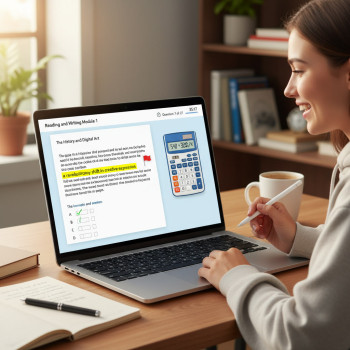Your teen just asked, “When should I start studying for the SAT?” and you froze. Too early seems crazy, but too late feels like setting them up for panic.
Here’s the truth: the ideal SAT prep timeline isn’t one-size-fits-all, but starting too late is the mistake most families regret. Finding the right balance between SAT preparation and maintaining sanity matters more than you think.
I’ve guided hundreds of students through this process, and I’ve noticed a pattern. The kids who approach the test strategically (not necessarily those who study longest) consistently outperform their peers.
But what exactly does “strategic preparation” look like? And how do you know if your teen should start six months before test day or an entire year ahead? The answer depends on three factors most parents completely overlook.
Understanding the SAT Timeline
Ideal Preparation Windows for Different Students
Most students don’t realize that SAT prep isn’t one-size-fits-all. Your ideal timeline depends on your starting point and target score.
- For the overachiever:
Start 9-12 months before your test date. This gives you breathing room to master concepts without cramming. You’ll thank yourself later when your friends are panicking and you’re confidently reviewing. - For the typical student:
6 months is your sweet spot. This timeline gives you enough runway to identify weaknesses, build skills, and take a few practice tests without upending your life. - For the procrastinator:
Even with just 3 months, you can make significant progress—but you’ll need to be disciplined and efficient. Focus on high-impact strategies and the most commonly tested concepts.
The Consequences of Starting Too Late
I’ve seen it countless times—students trying to cram everything two weeks before test day. The results aren’t pretty.
Starting too late means:
- Stress overload that actually lowers your performance
- No time to retake if you bomb the first attempt
- Missing application deadlines for early decision programs
- Settling for scores below your potential
When you rush SAT prep, you’re essentially throwing away free points that were yours for the taking.
Benefits of Early Preparation
Starting early is like finding money in your pocket you didn’t know was there.
You get to:
- Learn concepts thoroughly instead of memorizing tricks
- Take multiple practice tests to build stamina and confidence
- Identify and fix knowledge gaps methodically
- Schedule your actual SAT strategically
- Have time for a retake if needed
The best part? Early prep means studying in smaller, more manageable chunks. Your brain actually retains information better this way, compared to those marathon cram sessions.
Starting in Freshman Year
Building Core Academic Skills
Freshman year is prime time to build your foundation. The SAT tests core skills you’re already learning in school – algebra, reading comprehension, grammar, and writing. Instead of seeing these as separate from SAT prep, think of your everyday classes as SAT training grounds.
Pay extra attention in algebra and geometry classes. The math section isn’t about complex calculus – it’s about mastering the basics. When you’re reading in English class, practice identifying main ideas and supporting evidence. These are exactly the skills the SAT reading section measures.
Don’t skip grammar lessons either. Knowing when to use a semicolon might seem trivial now, but it’ll save you points later.
Establishing Strong Study Habits
The SAT isn’t just a test of knowledge – it’s a test of endurance. Freshman year is perfect for developing study habits that’ll carry you through test day.
Start small with 20-30 minute focused study sessions. No phone, no distractions. Gradually build up to longer periods that mimic actual test conditions.
Try different study methods to see what sticks. Flashcards for vocabulary? Practice problems for math?
Find your groove early.
Taking Preliminary Assessments
Dip your toes in the testing waters with the PSAT 8/9 or PSAT 10. These tests give you a taste of the format without the full pressure.
After taking these preliminary tests, analyze your results. Which sections tripped you up? Where did you excel? This early feedback is gold – it shows exactly where to focus your energy going forward.
Gradual Exposure to Test Content
No need to dive into full SAT practice tests right away. That’s overwhelming and unnecessary.
Instead, try one reading passage or a set of math problems each week. Get comfortable with the question styles and directions. Learn the patterns of what the test asks for.
By introducing content gradually, you’ll build confidence without burnout. The SAT won’t feel like a foreign language when you eventually tackle full practice tests junior year.
Junior Year: The Sweet Spot
Why Junior Year is Optimal for Most Students
Junior year hits that perfect balance for SAT prep. You’ve covered enough academic ground to
understand most test concepts, but you’re not drowning in college applications yet.
Think about it – sophomore year is often too early since you haven’t learned all the relevant math concepts. And senior year? That’s a pressure cooker of deadlines and applications.
Most students find junior year gives them that Goldilocks zone – not too early, not too late. By spring semester of junior year, you’ll have completed Algebra II and have solid reading comprehension skills.
The content actually makes sense by then!
Plus, your GPA from junior year carries serious weight with admissions officers. Pairing strong grades with impressive SAT scores sends a powerful message about your academic abilities.
Creating a Balanced Study Schedule
The key word here is “balanced.” No need to sacrifice your entire social life or quit the soccer team.
Start with 3-4 hours weekly, spread across different days. Maybe Tuesday and Thursday afternoons, plus Saturday morning. This approach beats cramming eight hours every Sunday.
Try this formula that works for most students:
- 40% practice questions
- 30% content review
- 30% full practice tests
Mix it up! Your brain retains information better when you switch between math, reading, and writing rather than drilling one section for hours.
Leveraging School Subjects for SAT Success
Your regular classes are secretly SAT prep in disguise.
That Shakespeare analysis in English class? It’s training you for reading comprehension. The algebra equations you’re solving? Direct SAT prep. Your history essays? They’re building the writing skills you need.
Make these connections:
- Algebra II → SAT math sections
- English literature → Reading comprehension
- Science labs → Data analysis questions
- History essays → Evidence-based reasoning
When you see the overlap, you’ll realize you’re already prepping just by paying attention in class.
Taking the PSAT as a Valuable Rehearsal
The PSAT isn’t just some practice test – it’s your dress rehearsal.
Taking the PSAT in fall of junior year gives you a realistic preview of test day conditions: the time pressure, the format, the environment. Plus, you’ll get detailed feedback on exactly where you’re strong and where you need work.
Bonus: high PSAT scores can qualify you for National Merit Scholarships. That’s potentially thousands in college money just for doing well on a practice test!
Use your PSAT score report like a treasure map – it points directly to the areas where you can gain the most points with focused study.
Planning for Multiple Test Attempts
Most top-scoring students take the SAT more than once. First-time jitters are real!
Starting in junior year gives you multiple shots at your target score. Try this timeline:
- First attempt: Spring of junior year
- Second attempt: Summer/early fall of senior year
- Final attempt (if needed): Late fall of senior year
Each attempt typically yields higher scores as test anxiety decreases and familiarity increases. Many students see a 50-100 point jump between their first and second tests.
Remember though – quality beats quantity. Three well-prepared attempts will serve you better than five hasty ones.
Accelerated Preparation Approaches
A. 3-Month Intensive Study Plans
Cramming for the SAT isn’t ideal, but sometimes you don’t have a choice. A 3-month plan can actually work wonders if you’re disciplined enough.
The key? Structure and consistency. Break down those three months into weekly goals. You’ll need to study about 10-15 hours per week – that’s just 2-3 hours per day with weekends off.
Here’s what works:
- Week 1-4: Master the fundamentals and take a practice test
- Week 5-8: Target your weak areas and take another practice test
- Week 9-12: Fine-tune with full practice tests and review mistakes
The biggest mistake students make with accelerated plans? Trying to cover everything. Don’t. Focus on high-impact areas where you can gain the most points quickly.
B. 6-Month Balanced Preparation Strategies
Six months gives you breathing room. You can study 5-10 hours weekly and still see amazing results. With this timeline, you’re not just memorizing – you’re actually learning. Your brain needs time to process new concepts, especially in math.
Try this approach:
- Month 1-2: Build your foundation and identify weak spots
- Month 3-4: Develop strategies for each section
- Month 5-6: Take full practice tests and refine your approach
The sweet spot? Most students find that 6 months hits the perfect balance between having enough time to improve and maintaining momentum throughout.
C. When Crash Courses Actually Work
Crash courses get a bad rap, but they can be lifesavers in specific situations.
They work best when:
- You already have strong academic skills
- You need structure more than content
- You’re looking to bump up an already decent score.
A two-week crash course won’t turn a 1000 into a 1500, but it might turn a 1350 into a 1450 if you’re already comfortable with the material.
The trick is to pair any crash course with independent study. Use the course to learn strategies and techniques, then practice independently to cement what you’ve learned.
Personalizing Your SAT Timeline
Assessing Your Starting Skill Level
The SAT isn’t a one-size-fits-all challenge. Some students already rock math but struggle with reading. Others can write essays in their sleep but freeze up during the math section.
Take a practice test ASAP—not tomorrow, not next week, right now. Seriously. Nothing gives you clearer insight than seeing your raw starting point. Those numbers don’t define you, but they’ll tell you exactly where to focus your energy.
If you’re scoring below 1000, you might need 6+ months of consistent prep. Hovering around 1200? You could potentially hit your target with 3-4 months of focused study. Already at 1400+? Lucky you—a few weeks of polishing specific areas might be all you need.
Considering Your Academic Workload
Your SAT prep doesn’t exist in a vacuum. That AP Chem class isn’t going to study for itself.
Junior year course load crushing you? Start SAT prep earlier, maybe summer before. Taking mostly regular classes with manageable homework? You can probably begin closer to your test date.
Some students find that SAT prep actually helps with regular coursework—especially for math and grammar concepts. Others need to separate these completely. Pay attention to your mental bandwidth.
Accounting for Extracurricular Commitments
Got sports seasons? Theater productions? Debate tournaments? Your SAT timeline needs to work around these.
Fall athlete? Consider spring testing. Spring sports star? Look at fall dates. The goal is to avoid your most intense extracurricular periods.
Many students make the mistake of trying to prep during their busiest seasons. You end up half-focusing on both your activities and the SAT, which serves nobody—especially not your test score.
Map out your year, marking peak busy periods in red. Those are your no-SAT-prep zones. Plan
accordingly.
Setting Realistic Score Goals
Your target score drives everything about your prep timeline. Going for a 200-point improvement? That’s different from gunning for a 400-point jump.
Be brutally honest with yourself here. Huge score improvements are possible, but they demand serious time. Most students see about 100-150 points of improvement with 40 hours of focused study.
Don’t chase arbitrary numbers. Research the average scores for your target schools. If your dream college’s middle 50% is 1250-1400, breaking your spirit to hit 1500+ might not be necessary.
Remember—the SAT measures test-taking skills as much as knowledge. Given enough time, almost anyone can dramatically improve. The question is: how much time do you have?
Preparing for the SAT is not a one-size-fits-all journey. While freshman year offers a gentle entry point through foundational academics and preliminary prep materials, junior year represents the ideal preparation window for most students. This strategic timing
allows for comprehensive content review, multiple practice tests, and sufficient time to address weaknesses before application deadlines. Your personal SAT timeline should reflect your unique academic strengths, college aspirations, and current commitments. Whether
you choose an early start, standard junior year approach, or accelerated preparation path, consistency is key. Begin with an honest assessment of your starting point, establish clear score goals, and develop a structured study plan that works with your schedule.
Remember that with thoughtful planning and dedicated effort, you can approach the SAT with confidence and achieve your target score.


















No Comments
Leave a comment Cancel